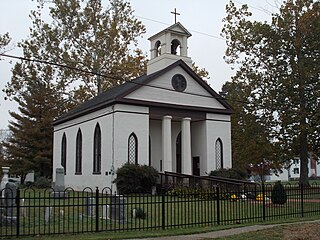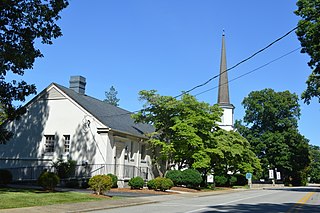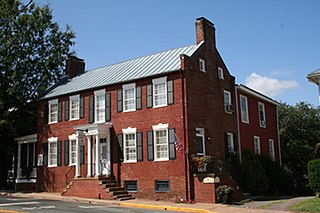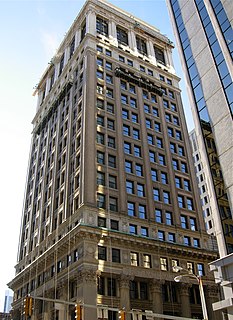
Charles Morrison Robinson, most commonly known as Charles M. Robinson, was an American architect. He worked in Altoona and Pittsburgh, Pennsylvania from 1889 to 1906 and in Richmond, Virginia from 1906 until the time of his death in 1932. He is most remembered as a prolific designer of educational buildings in Virginia, including public schools in Richmond and throughout Virginia, and university buildings for James Madison University, College of William and Mary, Radford University, Virginia State University, University of Mary Washington, and the University of Richmond. He was also the public school architect of the Richmond Public Schools from 1910 to 1929. Many of his works have been listed on the National Register of Historic Places.

Sabine Hall is a historic house located near Warsaw in Richmond County, Virginia. Built about 1730, it is one of Virginia's finest Georgian brick manor houses. It was built by noted planter Landon Carter (1710–1778). It was added to the National Register of Historic Places in 1969, and declared a National Historic Landmark in 1970.

Pocahontas Historic District is a national historic district located at Pocahontas in the Pocahontas coalfield, Tazewell County, Virginia. It is near Pocahontas Exhibition Coal Mine, a U.S. National Historic Landmark which was Mine No. 1 of the Pocahontas coalfield. The district encompasses 17 contributing buildings and 1 contributing structure in the town of Pocahontas. Notable buildings include the City Hall (1895), the stone Episcopal Methodist Church, Catholic Church, the old brick medical dispensary, a Synagogue, the first millinery shop in the coalfields and a Masonic Hall.

The Masonic Temple in Richmond, Virginia is a Richardsonian Romanesque style building built during 1888–1893, designed by Jackson C. Gott. The building was listed on the National Register of Historic Places in 1983.

Masons' Hall, located in the Shockoe Bottom neighborhood of Richmond, Virginia was built during 1785 to 1787 by Richmond Lodge No. 13. The building is still the active home of and owned by Richmond Randolph Lodge No.19 who have met in their third floor lodge room continuously since Masons’ Hall was completed in 1787. It was listed on the U.S. National Register of Historic Places in 1973.

The Hamilton Masonic Lodge is a historic brick building built in 1873, located in Hamilton, Virginia. Built in the Italianate style, it historically served as a Masonic meeting hall and as a school for grades 1−12.

The Church Hill North Historic District is a historic district in Richmond, Virginia, that was listed on the National Register of Historic Places in 1997. An expansion of the district was listed in 2000. This added 37 acres (15 ha) to the original 70 acres (28 ha)

Port Royal Historic District is a national historic district located at Port Royal, Caroline County, Virginia. The district encompasses 35 contributing buildings in the historic core of the 18th century tobacco port of Port Royal. Notable buildings include the 18th-century Fox's Tavern, the mid-19th century Masonic Hall, the 18th-century frame mansion of the Brockenbrough family, the Hipkins-Carr House, the Gray House, and St. Peter's Episcopal Church. Townfield and Riverview are separately listed.

Mountain Road Historic District is a national historic district in Halifax, Halifax County, Virginia. The district includes 22 contributing buildings located along Mountain Road and consists of two churches, a parish hall, a masonic hall, and a host of private residences dating to the 19th and early 20th centuries. Notable buildings include the Masonic Lodge (1828), Methodist Church (1831), St. John's Episcopal Church (1844), Magnolia Hill, Grand Oaks, and St. John's Rectory. Several of the earlier dwellings and St. John's Episcopal Church were designed by Dabney Cosby, Jr., son of the Jeffersonian workman, Dabney Cosby, Sr.

Orange Commercial Historic District is a national historic district located at Orange, Orange County, Virginia. One of Virginia's Main Street communities, it encompasses 61 contributing buildings in the central business district of Orange's county seat.

Edinburg Historic District is a national historic district located at Edinburg, Shenandoah County, Virginia. The district encompasses 292 contributing buildings, 6 contributing sites, 3 contributing structures, and 3 contributing objects in the town of Edinburg. It includes a variety of commercial, residential, and institutional buildings dating primarily from the time of its incorporation in 1852 to the mid-20th century. They are in a variety of popular architectural styles including Colonial Revival, Italianate, and Queen Anne. Notable buildings include the Philip Grandstaff House (1787), Edinburg Hotel, St. John's United Methodist Church (1916), Edinburg High School (1932-1933), Rush House, The Hatch, Piccadilly House (1850), Pres Grandstaff House, Masonic Building (1879), Harshman House (1900), Rest Haven Inn, Edinburg Train Station, Edinburg Village Shops (1896), Wrenn Building, Edinburg Town Hall (1903), St. Paul's United Church of Christ (1911), and the Mantz House (1930). Located in the district is the separately listed Edinburg Mill.

Hampton Downtown Historic District is a national historic district located at Hampton, Virginia. The district encompasses 25 contributing buildings and 7 contributing sites in the central business district of Hampton. The district includes a variety of commercial, residential, institutional, and governmental buildings dating from the late-19th to mid-20th century. There are notable examples of the Beaux-Arts, Art Deco, and Gothic Revival styles. Notable buildings include First United Methodist Church, the Sclater Building (1871), St. Tammany's Masonic Lodge (1888), Hampton Baptist Church (1883), Old Hampton Station Post Office (1914), and the circuit courthouse (1876). Located in the district and separately listed are St. John's Episcopal Church (1728) and the former Hampton City Hall (1939).

First National Bank Building is a historic bank and high-rise office building located at 823 East Main Street in Richmond, Virginia. It was designed by architect Alfred Bossom and built in 1912–1913. It is a 19-story, four bay by five bay, Classical Revival style steel frame building clad in brick, limestone, and granite. The building features rich architectural ornament that follows the Corinthian order both within and without. It was the first high-rise office tower to be built in Richmond. The First & Merchants Bank would eventually become Sovran Bank.

St. Andrew's Church is an historic Episcopal church complex in Richmond, Virginia, United States. The complex consists of the church (1901), school (1901), parish hall (1904), Instructive Nurse Association Building (1904), and William Byrd Community House or Arents Free Library (1908). The church is a rough-faced Virginia granite, cruciform Gothic Revival style structure dominated by a 115-foot corner tower. The school and parish hall are three-story, brick buildings on a stone basements.

The Laburnum Park Historic District is a national historic district located at Richmond, Virginia. The district encompasses 226 contributing buildings and 2 contributing structures located north of downtown Richmond. The primarily residential area developed starting in the early-20th century as one of the city's early "streetcar suburbs" and as home to several important local institutions. The buildings are in a variety of popular early-20th century architectural styles including Queen Anne and Colonial Revival. It was developed as neighborhood of middle-to-upper-class, single-family dwellings. Notable buildings include the Laburnum House (1908), Richmond Memorial Hospital (1954-1957), Richmond Memorial Hospital Nursing School (1960-1961), "The Hermitage" (1911), Laburnum Court (1919), Veritas School.

The Brookland Park Historic District is a national historic district located at Richmond, Virginia. The district encompasses 1,157 contributing buildings located north of downtown Richmond and Barton Heights. The primarily residential area developed starting in the late-19th century as one of the city's early “streetcar suburbs.” The buildings are in a variety of popular late-19th and early-20th century architectural styles including frame bungalows and American Foursquare. The neighborhood is characterized by frame dwellings with a single-story porch spanning the facade, and either Colonial Revival or Craftsman in style, moderate in scale, with understated materials and stylistic expression. Notable non-residential buildings include the North Side Branch building, Brookland Inn, former A&P Grocery Store, North Side Junior High School, Barack Obama Elementary School, St. Paul's School building (1923), St. Philip's Episcopal Church, First African Baptist Church (1922), and Garland Avenue Baptist Church.

The Fifth and Main Downtown Historic District is a national historic district located in downtown Richmond, Virginia. The district encompasses 38 contributing buildings and 1 contributing object located south of the Grace Street Commercial Historic District. It reflects the core of the city's early-20th century retail development. The district includes representative examples of the Federal, Greek Revival, Classical Revival and International Style architecture built between the mid-19th and mid-20th centuries. Notable buildings include the Equitable Life Insurance Building (1951), the Massey Building, and 400 East Main Street (1951). Located in the district is the separately listed St. Alban's Hall (1869).

Beverley Historic District is a national historic district located at Staunton, Virginia. The district encompasses 131 contributing buildings in downtown Staunton. It is a compact commercial district characterized by a well-preserved collection of 19th-century buildings. The buildings are characteristically two- to four-story, brick structures in a variety of popular architectural styles including Romanesque Revival and primarily Italianate. Notable buildings include the old YMCA (1890), Hoover House Hotel (1893-1894), Putnam Organ Works Store (1894), City Hall, Odd Fellows Hall, U.S. Post Office (1936), and the Masonic Temple building (1895-1896). Located in the district are the separately listed National Valley Bank and Augusta County Courthouse.

Suffolk Historic District is a national historic district located at Suffolk, Virginia. The district encompasses 514 contributing buildings, 3 contributing structures, and 3 contributing objects in Suffolk. The district includes a variety of residential, commercial, governmental, and institutional buildings. They are in a variety of vernacular and popular 19th and 20th century architectural styles including Greek Revival, Queen Anne, and Bungalow. Notable buildings include the Allmond Building (1914), Macedonia A.M.E. Church, National Bank of Suffolk (1914-1920), the Old Post Office, old Nansemond County Courthouse, John Granberry house, Richard Seth Eley House (1878), Jones Building, Suffolk Towers, Virginia Apartments (1918-1920), Causey-Kendrick house (1882), Masonic Hall (1911), Suffolk High School (1922), Jefferson High School (1911), old Methodist Church (1861), St. Paul's Episcopal Church (1895), Suffolk Christian Church (1893), and Congregation of Agudath Achin. Located in the district are the separately listed Phoenix Bank of Nansemond, Professional Building, and Riddick House.























